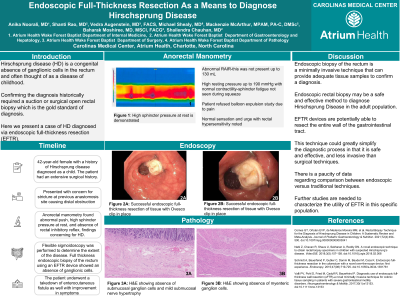Back


Poster Session B - Monday Morning
Category: Interventional Endoscopy
B0480 - Endoscopic Full-Thickness Resection as a Means to Diagnose Hirschsprung Disease
Monday, October 24, 2022
10:00 AM – 12:00 PM ET
Location: Crown Ballroom

Has Audio

Anika Noorali, MD
Atrium Health-Carolinas Medical Center
Charlotte, NC
Presenting Author(s)
Anika Noorali, MD1, Shanti Rao, MD1, Vedra Augenstein, MD1, Michael Shealy, MD1, Mackenzie McArthur, MPAM, PA-C, DMSc2, Baharak Moshiree, MD, MSCI, FACG3, Shailendra Chauhan, MD1
1Atrium Health-Carolinas Medical Center, Charlotte, NC; 2Atrium Health Wake Forest, Charlotte, NC; 3Atrium Health, Charlotte, NC
Introduction: Hirschsprung Disease (HD) is the congenital absence of ganglionic cells in the rectum and often thought of as a disease of childhood. However, this disease may persist into adulthood and symptoms such as chronic constipation can negatively affect quality of life. Patients often require a multidisciplinary approach between geneticists, colorectal surgeons, endoscopists and gastrointestinal pathologists during initial evaluation. Confirming the diagnosis has historically required a suction or open rectal biopsy, which is considered the gold standard for diagnosis. This is an invasive procedure that is prone to complications. Potential biopsy modalities include open, punch, suction and endoscopic. Interestingly, endoscopic biopsy using an endoscopic full-thickness resection (EFTR) device is rarely reported.
Case Description/Methods: Here we present a case of a 42-year-old female with a history of Hirschsprung disease diagnosed as a child. The patient had an extensive surgical history including colostomy, colostomy reversal, and closed loop obstruction. The patient had also been recently diagnosed with an enterocutaneous fistula. The patient was evaluated by a general surgeon who referred her to gastroenterology motility clinic. Gastrografin enema confirmed extensive stool burden without strictures. The patient underwent anorectal manometry, which found abnormal push, high sphincter pressure at rest, and absence in rectal inhibitory reflex, findings concerning for HD. A flexible sigmoidoscopy was performed to determine the extent of the disease. Full thickness endoscopic biopsy of the rectum using an EFTR device showed an absence of ganglionic cells. The patient underwent a takedown of enterocutaneous fistula as well with improvement in symptoms.
Discussion: Endoscopic biopsy of the rectum is a minimally invasive technique that can provide adequate tissue samples to confirm a diagnosis. There is a paucity of data regarding the comparison between endoscopic versus traditional techniques. Based on our experience, we suggest that endoscopic rectal biopsy may be a safe and effective method to diagnose Hirschsprung Disease in the adult population. EFTR devices are potentially able to resect the entire wall of the gastrointestinal tract. This technique could greatly simplify the diagnostic process in that it is safe and effective, and less invasive than surgical techniques. However, further studies are needed to better characterize the utility of this technique in this specific patient population.

Disclosures:
Anika Noorali, MD1, Shanti Rao, MD1, Vedra Augenstein, MD1, Michael Shealy, MD1, Mackenzie McArthur, MPAM, PA-C, DMSc2, Baharak Moshiree, MD, MSCI, FACG3, Shailendra Chauhan, MD1. B0480 - Endoscopic Full-Thickness Resection as a Means to Diagnose Hirschsprung Disease, ACG 2022 Annual Scientific Meeting Abstracts. Charlotte, NC: American College of Gastroenterology.
1Atrium Health-Carolinas Medical Center, Charlotte, NC; 2Atrium Health Wake Forest, Charlotte, NC; 3Atrium Health, Charlotte, NC
Introduction: Hirschsprung Disease (HD) is the congenital absence of ganglionic cells in the rectum and often thought of as a disease of childhood. However, this disease may persist into adulthood and symptoms such as chronic constipation can negatively affect quality of life. Patients often require a multidisciplinary approach between geneticists, colorectal surgeons, endoscopists and gastrointestinal pathologists during initial evaluation. Confirming the diagnosis has historically required a suction or open rectal biopsy, which is considered the gold standard for diagnosis. This is an invasive procedure that is prone to complications. Potential biopsy modalities include open, punch, suction and endoscopic. Interestingly, endoscopic biopsy using an endoscopic full-thickness resection (EFTR) device is rarely reported.
Case Description/Methods: Here we present a case of a 42-year-old female with a history of Hirschsprung disease diagnosed as a child. The patient had an extensive surgical history including colostomy, colostomy reversal, and closed loop obstruction. The patient had also been recently diagnosed with an enterocutaneous fistula. The patient was evaluated by a general surgeon who referred her to gastroenterology motility clinic. Gastrografin enema confirmed extensive stool burden without strictures. The patient underwent anorectal manometry, which found abnormal push, high sphincter pressure at rest, and absence in rectal inhibitory reflex, findings concerning for HD. A flexible sigmoidoscopy was performed to determine the extent of the disease. Full thickness endoscopic biopsy of the rectum using an EFTR device showed an absence of ganglionic cells. The patient underwent a takedown of enterocutaneous fistula as well with improvement in symptoms.
Discussion: Endoscopic biopsy of the rectum is a minimally invasive technique that can provide adequate tissue samples to confirm a diagnosis. There is a paucity of data regarding the comparison between endoscopic versus traditional techniques. Based on our experience, we suggest that endoscopic rectal biopsy may be a safe and effective method to diagnose Hirschsprung Disease in the adult population. EFTR devices are potentially able to resect the entire wall of the gastrointestinal tract. This technique could greatly simplify the diagnostic process in that it is safe and effective, and less invasive than surgical techniques. However, further studies are needed to better characterize the utility of this technique in this specific patient population.

Figure: Figure 1A: H&E showing absence of myenteric ganglion cells
Figure 1B: Successful endoscopic full-thickness resection of tissue with Ovesco clip in place
Figure 1B: Successful endoscopic full-thickness resection of tissue with Ovesco clip in place
Disclosures:
Anika Noorali indicated no relevant financial relationships.
Shanti Rao indicated no relevant financial relationships.
Vedra Augenstein indicated no relevant financial relationships.
Michael Shealy indicated no relevant financial relationships.
Mackenzie McArthur: Abbvie – Speakers Bureau. Coloplast – Advisory Committee/Board Member. Evoke – Advisory Committee/Board Member. Phathom Pharmaceuticals – Advisory Committee/Board Member, Speakers Bureau. Salix Pharmaceuticals – Advisory Committee/Board Member, Speakers Bureau. Sanofi – Advisory Committee/Board Member.
Baharak Moshiree indicated no relevant financial relationships.
Shailendra Chauhan indicated no relevant financial relationships.
Anika Noorali, MD1, Shanti Rao, MD1, Vedra Augenstein, MD1, Michael Shealy, MD1, Mackenzie McArthur, MPAM, PA-C, DMSc2, Baharak Moshiree, MD, MSCI, FACG3, Shailendra Chauhan, MD1. B0480 - Endoscopic Full-Thickness Resection as a Means to Diagnose Hirschsprung Disease, ACG 2022 Annual Scientific Meeting Abstracts. Charlotte, NC: American College of Gastroenterology.
